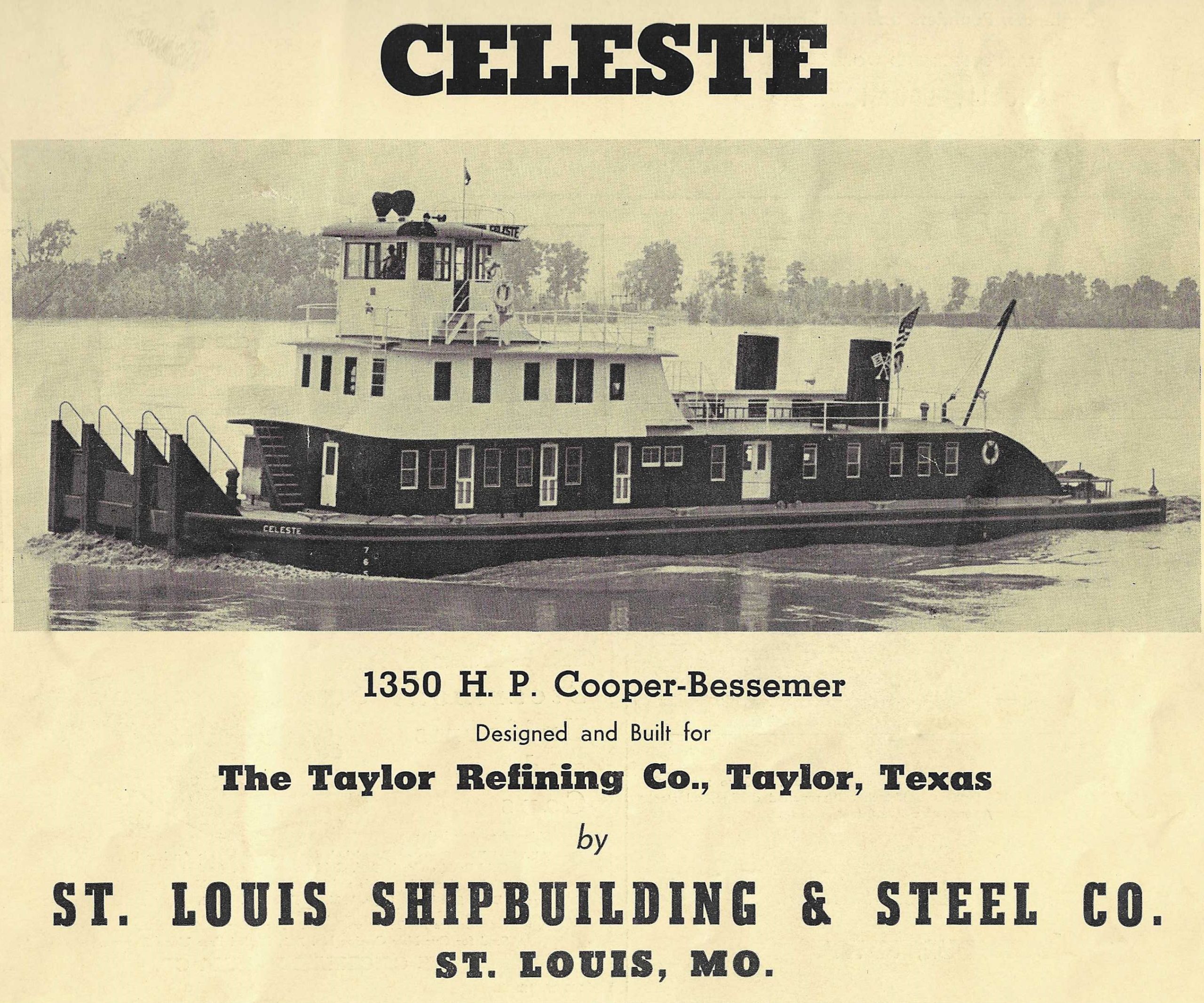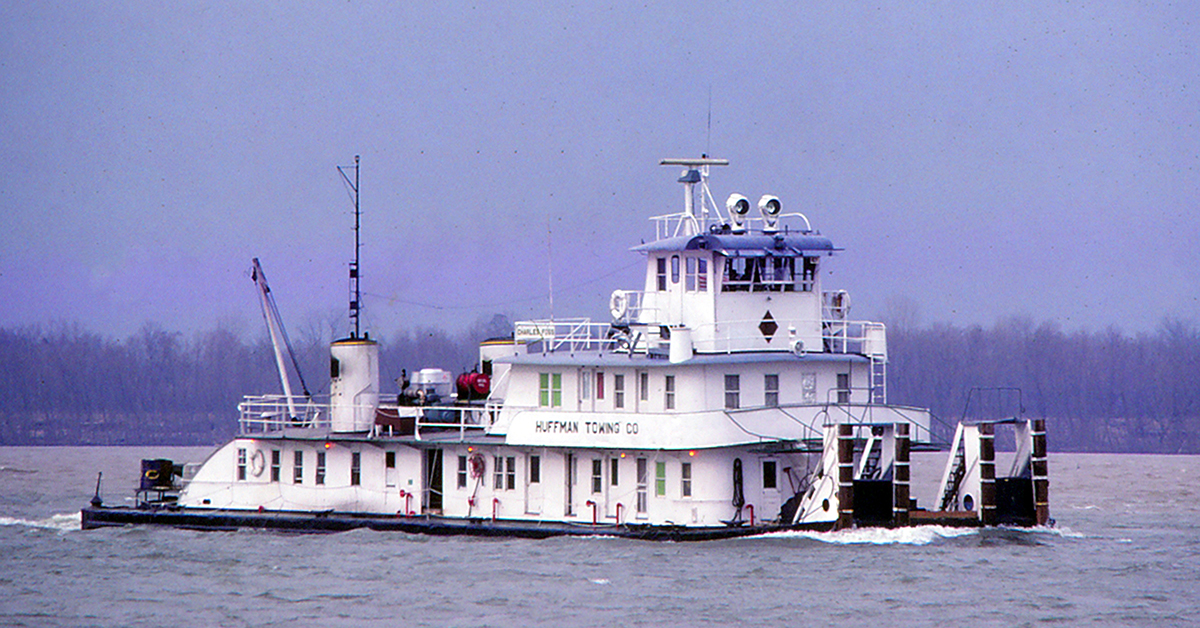This column has often referenced St. Louis Shipbuilding & Steel Company, which was established by Herman Pott and others in 1933. The shipyard occupied the site of the former Rohan Boat, Boiler & Tank Company in the Carondelet section of St. Louis. That site was also where James B. Eads built Union Navy ironclad gunboats during the Civil War. The firm built small towboats for its first five years, then turned out the “streamlined and air-conditioned” J.H. Duffy for the Ohio River Sand Company of Louisville, Ky. To learn more about that boat, see The Waterways Journal, August 7, 2023.
The hull of the Duffy, the largest boat St. Louis Ship had built at that point, measured 130 feet by 30 feet, and the vessel produced 900 hp. St. Louis Ship built several other significant boats after the Duffy, with some having the shapely cabin designs the shipyard became known for.
In 1942, St. Louis Ship turned out a vessel that the May 30 issue of the WJ described as “representing a number of novel innovations in Mississippi River craft.” This was an all-steel, twin-screw towboat with a hull that was 124 feet by 30 feet and had a total of seven rudders, three steering and four flanking. It was described as owned by Taylor Refining Company of Taylor, Texas, but the story went on to say St. Louis Ship built the boat and 10 barges for “J.B. Saunders of the Triangle Refineries, St. Louis; C.C. Rockenback, St. Louis; the Taylor Refining Company of Corpus Christi, Texas; and the Coastal Refineries of Port Isabel, Texas.” The new boat was to be operated by the Butcher-Arthur Company of Houston.

The boat was launched on May 23, 1942, and named Celeste in honor of Mrs. C.C. Rockenback, who also broke the traditional bottle of champagne on the bow of the vessel at a ceremony held that day. In front of some 150 invited guests, Rockenback was also presented with a sterling silver model of the boat by Herman Pott, president of St. Louis Ship. A portrait of Rockenback was hung on the forward bulkhead of the second deck officer’s lounge.
During her speech at the ceremony, the vessel’s namesake addressed Capt. Berchman Chotin, master, by saying, “Captain, I trust each journey will not only be a safe one but more pleasant and successful than the preceding. I hope my name ‘Celeste’ will bring as much good fortune and good luck to this vessel and its friends as it has brought to me. Captain, may she always do you proud!”
This issue featuring the Celeste contained many ads from businesses congratulating the new boat. A full page spread by Cooper-Bessemer Corporation depicted one of the two C-B JSDR-8-cylinder diesels that produced the boat’s 1,350 total hp. at 375 rpm but had the capability of producing 1,620 hp. at 450 rpm. The engines were controlled from the pilothouse by a unique Sperry hydraulic engine control system. Each control consisted of two levers, one to determine forward or reverse and the other to start, stop and select the engine speed. Another unique feature was that the main engines were situated well aft in the boat, rather than forward or near mid-ship. This unusual positioning was to allow for shorter propeller shafting, which reduced vibrations and also allowed the crew quarters to all be forward of the noisy engine room.
The May 30 WJ also had ads for Sperry Products, Fairbanks-Morse (which supplied the generator engines), Sterling Steel Casting Company, Granite City Steel Company and suppliers of electrical systems and furnishings. St. Louis Ship had a front cover ad with a “glamour shot” of the Celeste. G.L. Rowsey, president of Coastal Refineries and Taylor Refining Company, J.B. Saunders and C.C. Rockenback said in a full-page ad on page 17, “Our compliments and appreciation to all for their kind cooperation in creating our new towboat Celeste.”
The Celeste departed St. Louis on May 27 with two of the 10 new barges from St. Louis Ship. It proceeded to Gretna, La., where it picked up an oil tow destined for the Pittsburgh area on the Ohio River. The initial crew consisted of Capt. Berchman Chotin, master; Capt. Walter Gilmore, pilot; Louis Buchanan, chief engineer; George W. Miller, assistant engineer; Maurice Bowie, mate; Eugene Hubbard, tankerman; A.J. Schellinger, oiler; deckhands Merrill Habert, Fred Houchin, Edward Wolfe and Stanley Guthrie; Lee Randolph, cook; and Julia Randolph, maid. In a front cover ad of the August 29, 1942, issue of the WJ, the Cooper-Bessemer Corporation featured the new Celeste and said, “On her maiden voyage, Southern States Barge Lines’ new towboat Celeste pushed 6,700 tons of oil, in six barges, from Norco, La., to Cincinnati, Ohio, at an average speed of 3 mph!” This was the first mention of Southern States Barge Line. The Celeste originally had the radio call sign KREF, which was later changed to WB 5634.
The initial 1945 edition of the Inland River Record listed the owner of the Celeste as Taylor Refining Company. In 1946, Butcher-Arthur was listed as the owner. Then, in 1948, Southern States Towing, a division of Triangle Refineries, St. Louis, was listed as the owner. In 1969, the Celeste was shown as being leased to Huffman Towing Company, St. Louis. In 1971, it was listed as having been sold to Huffman in January of that year, but later editions of the IRR record it as being sold to Huffman in 1968. In any case, Huffman renamed it the Charles Foss in April 1974.
In June 1983, the Charles Foss was sold to Coastal Water Transportation Inc., Valparaiso, La. The 1990 IRR listed it in the “Off The Record” section with the note of “Burned several years ago.”
The boat operated throughout its life with no appreciable change in its outward appearance, and it was never repowered.




